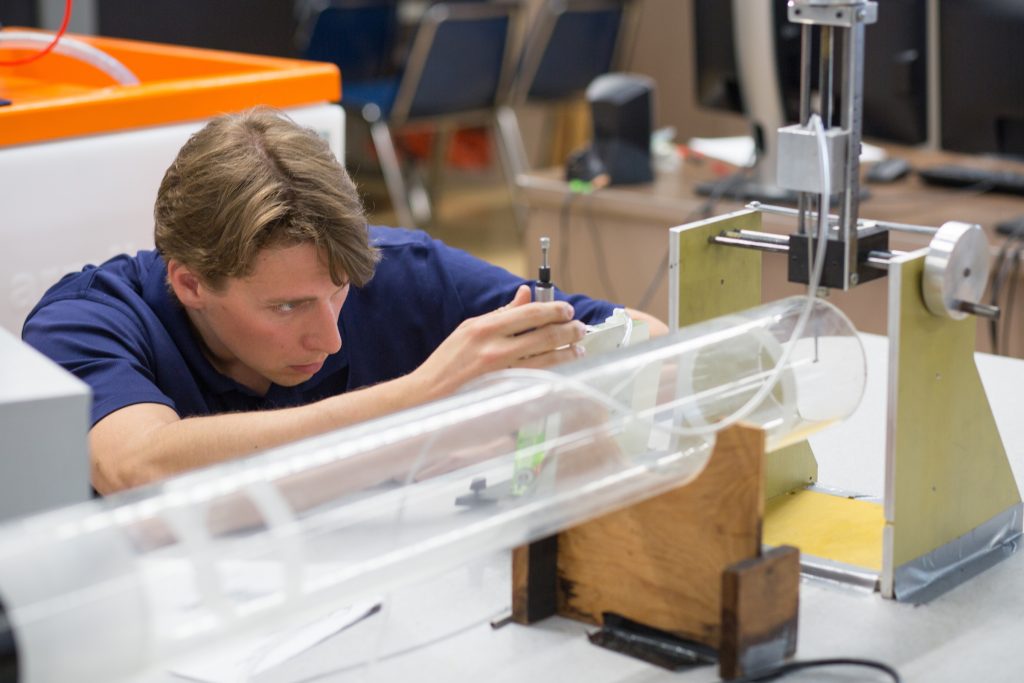Feb. 13, 2019
The College of Engineering, Informatics, and Applied Sciences hasn’t even had its first birthday yet, and it’s already making history, becoming the first college at Northern Arizona University to have a Ph.D. program in each of its departments.
The Arizona Board of Regents voted last week to approve three new programs for the college. Doctoral programs in mechanical engineering and applied physics and materials science (APMS) will begin in the fall, with the civil and environmental engineering program starting in fall 2020. This step is a testament to NAU’s commitment to cutting-edge research and technology and providing valuable, hands-on experiences to ensure students are prepared for their careers.
“In the sciences and engineering, we teach existing knowledge, so we want students to have the understanding of the discipline,” Interim Dean Diane Stearns said. “But the whole point of science is solving a problem and creating new knowledge and creating best practice. That is research. Whether it’s undergrads or grad students, if we’re not teaching them what research is so that they understand where the knowledge comes from, we haven’t given them a complete education.”
The programs will start small with the faculty and research already at NAU and admitting a small cohort of students through unofficial recruiting. Stearns’ goal as of now is hiring 23 additional faculty members in the next seven years, but that’s fluid and depends on the number of students they have, she said. NAU gets a certain number of new tenure-track faculty positions spread across all the colleges each year, and CEIAS will take turns with the other colleges as those are assigned, Stearns said.
Although universities nationwide are seeing decreases in enrollment, that trend is not in play with engineering programs. The demand throughout the country is increasing and more fields require employees with backgrounds in engineering, informatics and applied physics; as more undergraduate students choose these majors, universities need more doctoral students and faculty members to teach those students. The Ph.D. programs were a natural step in each of these departments.
“We created the College of Engineering, Informatics, and Applied Sciences to help NAU better meet the demands of these cutting-edge industries, and these new programs are the next step in doing that,” President Rita Cheng said. “Both undergraduate and graduate students will have more opportunities to engage in hands-on research and learning, which are critical preparations for success in these fields.”
CEIAS already has doctoral programs in informatics and computing and bioengineering.
“The point is to strengthen the undergrad teaching mission,” Stearns said. “We want to provide our students with the most cutting-edge experience. We have a history of our students getting hands-on experience. They’re in the lab with the faculty. That’s not going to change.”
APMS program director Gabe Montaño said this Ph.D. curriculum will be interdisciplinary and appropriate for students with backgrounds in chemistry, biology, engineering and physics. Such collaboration is necessary in the industries they’ll be entering.
“The key is to be able to do that while still creating scientists who are very good at what they do,” he said. “These students will have their expertise and will also be able to traverse a wide range of disciplines, be able to collaborate more freely, be more adaptable to how research will be done in the future. They’ll really be able to solve big, complex science.”
That leads him to another big, complex problem—the lack of diversity in STEM fields and STEM education. Four out of every five STEM professors in this country are white men, meaning women and underrepresented minority students walk into classes, don’t see people who look like them and aren’t sure there’s a path forward in this field. Montaño, who went to high school, college and graduate school in the Southwest, never had a Hispanic professor in a science or math class. He and Jen Martinez, director of the Center for Materials Interfaces in Research and Applications (abbreviated to ¡MIRA!, which means “look” in Spanish) are leading CEIAS’ efforts to build proportionate representation among gender, race and ethnicity at every level—undergraduate and graduate students along with faculty members and researchers.
“It matters,” Montaño said. “Students want to see themselves reflected in their leadership.”
More information, including how to enroll in these programs, can be found on the CEIAS Ph.D. program’s website.
[accordion]
Learn more about the three new Ph.D. programs:
Mechanical engineering
Mechanical engineers work in a wide spectrum of industries, including energy, security and defense, space exploration, technology and health care; the Bureau of Labor Statistics predicted a 9 percent growth rate in the industry between 2016 and 2026. The department already has strong research-active faculty that can support a few doctoral students.
Applied physics and materials science
This is the first program of its kind in Arizona and will position NAU to increase research capacity and attract top students to this transdisciplinary program. Stearns said this field is expanding as new smart and adaptive materials and structures are created. A variety of engineering and natural sciences disciplines overlap with APMS. It also will make physics students more marketable, she said.
Civil and environmental engineering
The civil and environmental engineering is taking an extra year to ramp up because the department is smaller, Stearns said; faculty members need more time to ensure they have sufficient capacity to support doctoral students. But it is needed. This program and its focus on infrastructure resilience will foster the development of research capacity and scientific discovery in a high-growth area that is critical to Arizona and the nation.
The Bureau of Labor Statistics anticipated 11 percent growth in the civil engineering industry through 2026.
[/accordion]

(928) 523-8737 | heidi.toth@nau.edu



